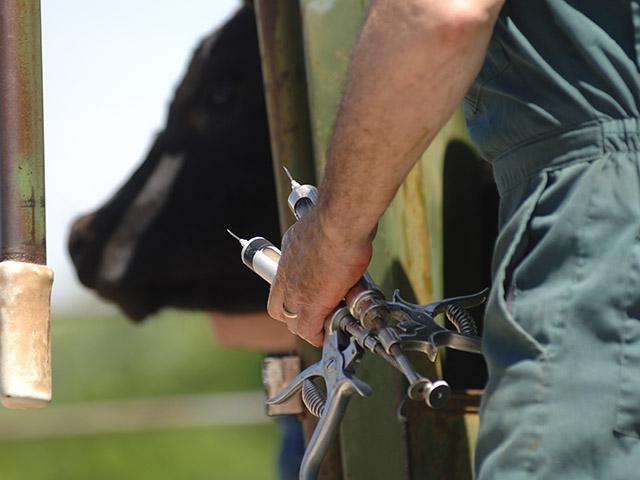Trying to Stem a Rural Veterinary Crisis
Veterinarians, State Ag Directors Champion Rural Veterinary Workforce Act
WASHINGTON (DTN) -- Just down the street from each other, groups representing the nation's veterinarians and state agricultural directors are both raising concerns about the growing shortage of rural veterinarians who treat food animals.
"That is absolutely a challenge and we know that we're seeing fewer and fewer veterinarians in rural areas," said Rena Carlson, an Idaho veterinarian and president of the American Veterinary Medical Association (AVMA).
The AVMA was in Washington, D.C., to lobby for its priorities, which include legislation to boost the number of rural veterinarians.
The shortage of rural veterinarians also was a major point of discussion at the National Association of State Directors of Agriculture (NASDA), which was also holding its winter policy meeting just a block away from the AVMA gathering this week.
Michael Strain, the Louisiana commissioner of agriculture and a licensed veterinarian, added the problem is exacerbated as the older generation of veterinarians who could afford to maintain a rural practice are now retiring.
"When you look at this from food security and national security, this is an imperative. There are solutions but none of them are immediate," he said.
LOAN REPAYMENT PROGRAMS
USDA operates the Veterinary Medicine Loan Repayment Program, which repays up to $25,000 a year in student loan debt for three years -- $75,000 total -- for veterinarians to choose to practice in areas USDA designates as having a shortage of large-animal veterinarians. Right now, data shows there are 240 areas around the country in 47 states that qualify -- the highest since USDA started keeping track of that data.
"And if you look at the last five years, we've seen a 20% increase in the number of shortage areas," Carlson said.
P[L1] D[0x0] M[300x250] OOP[F] ADUNIT[] T[]
The Rural Veterinary Workforce Act would provide an exemption from the federal income withholding tax for rural veterinary loan repayments and similar state programs, helping allow more veterinarians to practice in rural communities where their services are needed most. Further, the bill would expand the ability to fund more loan repayment awards by rolling tax money back into the program.
"For every three veterinarians that we're able to give that loan repayment program to, we could add one more through this act," Carlson said. "This will go a long way to improve the ability to sustain a practice in rural America."
The legislation has been introduced multiple times and has dozens of co-sponsors in both the Senate and House. Because the bill is essentially tax legislation, it would have to come through the House Ways & Means Committee and Senate Finance Committee.
There are roughly 80 veterinarians every year who are approved for the loan repayment program. With the tax change, Carlson said it could bump up to potentially 115 loan repayment awards annually. There are typically more than twice as many people who apply for the loan repayment program than are approved.
"We know there are more people who apply than are funded through the program," she said.
COST OF EDUCATION
Generally, the average cost of a year in veterinary school is around $50,000 a year, typically meaning graduates are leaving school averaging roughly $180,000 in loan debt. That loan debt makes it hard to pencil out a living for young rural veterinarians, Strain said.
"It's hard to find a food-animal practice that justifies paying for a mortgage, your family and paying that debt," Strain said.
Agricultural commissioners suggested the $75,000 in loan repayment also needs to be extended.
Strain said the struggles of the rural veterinary workforce go back more than a dozen years and are now reaching a crisis point for livestock producers. In situations where livestock needs certain vaccinations that require a licensed veterinarian, Strain said there are a lot of areas where those animals simply aren't treated.
Further, most veterinarians from urban areas don't have an interest in moving to a rural area to start their practice. Strain said there need to be changes in the way veterinarian schools recruit and accept prospective students. A rural student who grew up on a farm is more likely to consider practicing in rural areas.
"We have to recruit people who will be inclined to go back home and practice food-animal medicine," Strain said.
Jeff Witte, New Mexico's director of agriculture, said another problem is that veterinary practices are becoming similar to medical practices with consolidation as veterinarians share expensive diagnostic equipment, which again forces more veterinarians to practice in urban areas.
"I think the voluntary loan repayment program is a good tool, but it's not enough," Witte said.
Details on Veterinary Medicine Loan Repayment Program:
Chris Clayton can be reached at Chris.Clayton@dtn.com
Follow him on X, formerly known as Twitter, @ChrisClaytonDTN
(c) Copyright 2024 DTN, LLC. All rights reserved.



